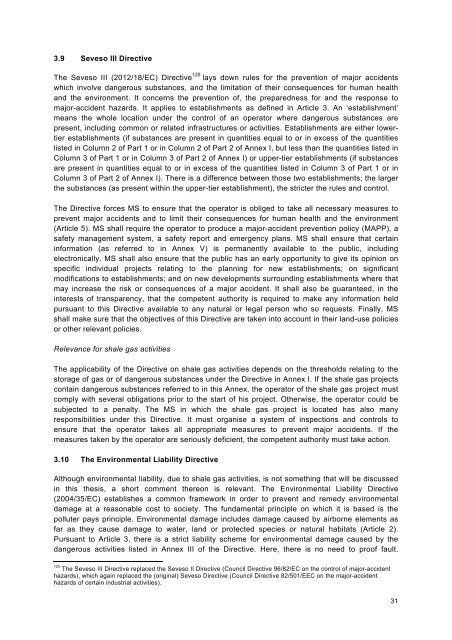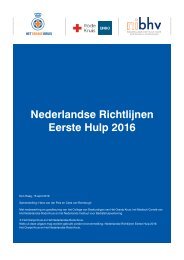Thesis-Anne-Vos-Masters-SBR-and-EU-Law-3
Thesis-Anne-Vos-Masters-SBR-and-EU-Law-3
Thesis-Anne-Vos-Masters-SBR-and-EU-Law-3
Create successful ePaper yourself
Turn your PDF publications into a flip-book with our unique Google optimized e-Paper software.
3.9 Seveso III Directive<br />
The Seveso III (2012/18/EC) Directive 125 lays down rules for the prevention of major accidents<br />
which involve dangerous substances, <strong>and</strong> the limitation of their consequences for human health<br />
<strong>and</strong> the environment. It concerns the prevention of, the preparedness for <strong>and</strong> the response to<br />
major-accident hazards. It applies to establishments as defined in Article 3. An ‘establishment’<br />
means the whole location under the control of an operator where dangerous substances are<br />
present, including common or related infrastructures or activities. Establishments are either lowertier<br />
establishments (if substances are present in quantities equal to or in excess of the quantities<br />
listed in Column 2 of Part 1 or in Column 2 of Part 2 of <strong>Anne</strong>x I, but less than the quantities listed in<br />
Column 3 of Part 1 or in Column 3 of Part 2 of <strong>Anne</strong>x I) or upper-tier establishments (if substances<br />
are present in quantities equal to or in excess of the quantities listed in Column 3 of Part 1 or in<br />
Column 3 of Part 2 of <strong>Anne</strong>x I). There is a difference between those two establishments; the larger<br />
the substances (as present within the upper-tier establishment), the stricter the rules <strong>and</strong> control.<br />
The Directive forces MS to ensure that the operator is obliged to take all necessary measures to<br />
prevent major accidents <strong>and</strong> to limit their consequences for human health <strong>and</strong> the environment<br />
(Article 5). MS shall require the operator to produce a major-accident prevention policy (MAPP), a<br />
safety management system, a safety report <strong>and</strong> emergency plans. MS shall ensure that certain<br />
information (as referred to in <strong>Anne</strong>x V) is permanently available to the public, including<br />
electronically. MS shall also ensure that the public has an early opportunity to give its opinion on<br />
specific individual projects relating to the planning for new establishments; on significant<br />
modifications to establishments; <strong>and</strong> on new developments surrounding establishments where that<br />
may increase the risk or consequences of a major accident. It shall also be guaranteed, in the<br />
interests of transparency, that the competent authority is required to make any information held<br />
pursuant to this Directive available to any natural or legal person who so requests. Finally, MS<br />
shall make sure that the objectives of this Directive are taken into account in their l<strong>and</strong>-use policies<br />
or other relevant policies.<br />
Relevance for shale gas activities<br />
The applicability of the Directive on shale gas activities depends on the thresholds relating to the<br />
storage of gas or of dangerous substances under the Directive in <strong>Anne</strong>x I. If the shale gas projects<br />
contain dangerous substances referred to in this <strong>Anne</strong>x, the operator of the shale gas project must<br />
comply with several obligations prior to the start of his project. Otherwise, the operator could be<br />
subjected to a penalty. The MS in which the shale gas project is located has also many<br />
responsibilities under this Directive. It must organise a system of inspections <strong>and</strong> controls to<br />
ensure that the operator takes all appropriate measures to prevent major accidents. If the<br />
measures taken by the operator are seriously deficient, the competent authority must take action.<br />
3.10 The Environmental Liability Directive<br />
Although environmental liability, due to shale gas activities, is not something that will be discussed<br />
in this thesis, a short comment thereon is relevant. The Environmental Liability Directive<br />
(2004/35/EC) establishes a common framework in order to prevent <strong>and</strong> remedy environmental<br />
damage at a reasonable cost to society. The fundamental principle on which it is based is the<br />
polluter pays principle. Environmental damage includes damage caused by airborne elements as<br />
far as they cause damage to water, l<strong>and</strong> or protected species or natural habitats (Article 2).<br />
Pursuant to Article 3, there is a strict liability scheme for environmental damage caused by the<br />
dangerous activities listed in <strong>Anne</strong>x III of the Directive. Here, there is no need to proof fault.<br />
125<br />
The Seveso III Directive replaced the Seveso II Directive (Council Directive 96/82/EC on the control of major-accident<br />
hazards), which again replaced the (original) Seveso Directive (Council Directive 82/501/EEC on the major-accident<br />
hazards of certain industrial activities).<br />
31



